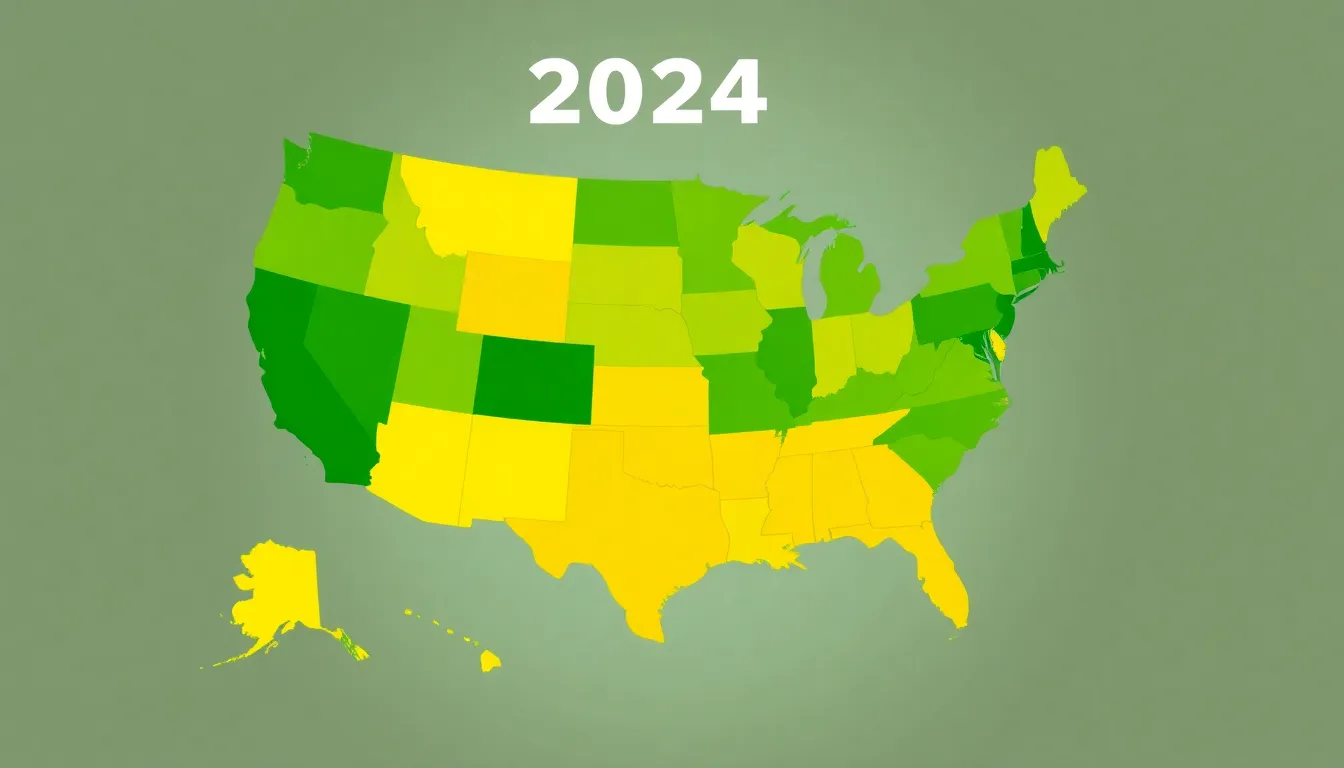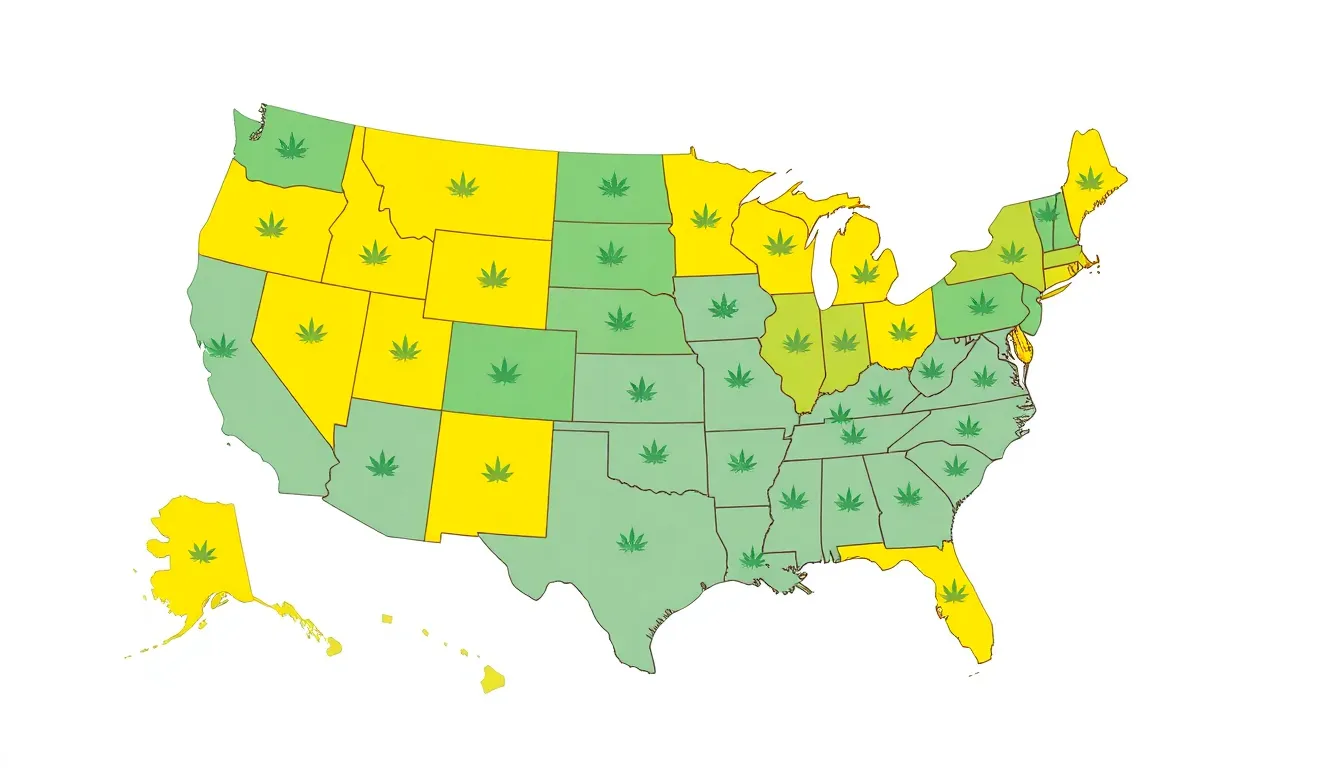In 2024, the green wave of legal marijuana continues to sweep across the United States, leaving a trail of happy, relaxed citizens in its wake. If you’ve ever dreamed of lighting up without looking over your shoulder, this year might just be your golden ticket. With more states embracing the herb, it’s time to take a closer look at the evolving landscape of legal marijuana.
Table of Contents
ToggleOverview of Legal Marijuana States in 2024
In 2024, numerous states have embraced legal marijuana, reflecting changing attitudes toward its use. States like California, Colorado, and Illinois lead the way, having fully legalized both medical and recreational marijuana. A growing number of states now allow adult use, indicating a significant shift in public perception.
Alaska, Maine, and Massachusetts also contribute to this trend. Medical use remains prevalent in states such as Florida and Ohio, which recognize the therapeutic benefits of cannabis. As legalization expands, consumers gain safer access to marijuana products.
The map of legal marijuana states showcases a diverse landscape. A total of 23 states plus Washington D.C. have legalized recreational marijuana, fostering economic growth and tax revenue. Additionally, states like New Mexico and New York have enacted laws supporting social equity in this emerging market.
Limitations still exist in some regions, with states like Idaho and Nebraska maintaining strict prohibition. However, advocates continue to push for reform, emphasizing the potential benefits of legalizing marijuana for residents and local economies.
Data from the American Civil Liberties Union indicates significant decreases in marijuana-related arrests in states where legalization has occurred. This trend highlights the positive social impact of legal marijuana, including reduced criminalization and improved public health outcomes.
Overall, 2024 marks a pivotal year for the legalization movement in the United States. The continued expansion of legal marijuana reflects a broader acceptance and understanding of its benefits, paving the way for future reforms across the nation.
Key Changes in Legislation

2024 has brought noteworthy shifts in marijuana legislation across various states. The growing acceptance of cannabis is evident as states adopt new laws.
Recent Legalizations
Recent legalizations have significantly transformed the landscape of marijuana in the U.S. States such as New Mexico and New York have legalized recreational use, following the trend set by California and Colorado. In addition, new legislative measures in Connecticut and Rhode Island have expanded access, encouraging more residents to take advantage of legal marijuana. Rapid changes reflect evolving public attitudes. Positive economic outcomes have prompted leaders in these states to embrace legalization, which generates tax revenue and creates job opportunities.
States Maintaining Status Quo
Some states remain entrenched in their previous marijuana policies. Idaho and Nebraska continue to uphold strict prohibition, resisting calls for reform. States like South Dakota and Wyoming have not pursued significant changes, leaving existing laws in place. Resistance often stems from longstanding social and political beliefs surrounding marijuana use. Despite mounting pressure from advocacy groups, these states have yet to explore options for legalization or decriminalization. Such hesitance contrasts sharply with the progress seen in other regions, illustrating the divided landscape of marijuana legislation across the nation.
Detailed Legal Marijuana States 2024 Map
The 2024 legal marijuana map showcases the evolving landscape of marijuana legality in the United States. This interactive resource allows users to explore various state regulations to stay informed.
Interactive Features of the Map
Users can click on individual states to access detailed legal information about marijuana use. Each state’s specific guidelines for medical and recreational use are displayed. Additionally, interactive features foster engagement by providing updates and links to legislative changes. Users benefit from the map’s zoom functionality, enabling a closer look at regional developments. Hotspots indicate areas with new initiatives or legislation.
Color-Coding for Legality
Different colors represent various legal statuses across the map. States with fully legalized recreational marijuana are marked in green, reflecting their progressive stance on cannabis. Yellow indicates states allowing only medical use, enabling access to therapeutic benefits while limiting recreational consumption. Gray represents prohibition, showing areas yet to embrace legalization. This color-coding visually simplifies complex regulations, allowing quick comprehension of each state’s legal standing. Users find this feature particularly helpful when comparing policies across regions.
Economic Impact of Legalization
Economic growth significantly benefits from marijuana legalization. States with legalized cannabis markets report increased tax revenues. For instance, Colorado generated over $423 million in tax revenue in 2021 alone. Employment opportunities grow as well; the legal marijuana industry creates thousands of jobs, ranging from cultivation to retail.
Investment in communities occurs when local businesses expand due to increased foot traffic. Small businesses thrive by entering the cannabis sector, which boosts local economies. States like California and Illinois illustrate this trend, showing rising employment and economic stimulation.
Public health funding increases following legalization, as new tax revenues often support education and health initiatives. Programs that focus on substance abuse prevention and mental health resources receive additional funding.
Social equity efforts emerge as crucial elements of the economic landscape. States such as New York implement initiatives aimed at supporting communities disproportionately affected by past prohibition. This approach cultivates a more inclusive market environment.
Long-term economic benefits include a decrease in law enforcement costs related to marijuana offenses. Law enforcement agencies save resources that can be redirected toward other community needs. Decrease in criminal charges contributes to a reduction in incarceration rates, positively impacting families and communities.
Overall, the economic implications of marijuana legalization underscore the financial advantages for both state governments and communities, reflecting a broader acceptance of cannabis across the United States.
Social and Health Implications
Legal marijuana has significant social and health implications across states that have adopted legalization. Research indicates that states embracing legalization see notable decreases in marijuana-related arrests. This decline benefits communities, reducing the stigma around cannabis use and promoting a shift in societal attitudes.
Access to legal marijuana supports public health initiatives, particularly regarding mental health and substance abuse resources. States like New York are prioritizing funding for programs that aid rehabilitation and recovery, illustrating how tax revenues from cannabis can enhance community health efforts. Increased availability allows individuals to explore alternatives for managing conditions such as anxiety and chronic pain.
Also, educational campaigns targeting responsible consumption can arise from legalized markets. These campaigns help inform users about dosage, potential side effects, and safe usage practices, fostering a culture of responsibility. Data highlights that informed users experience more positive health outcomes compared to those who consume cannabis without guidance.
In addition, legalization opens dialogues about drug policy and social equity. Engaging discussions lead to reforms aimed at addressing injustices faced by communities disproportionately affected by past drug laws. Through these reforms, priorities focus on creating opportunities within the cannabis industry for all demographics.
Challenges in states maintaining prohibition contrast with regions experiencing the benefits of legalization. As reform supporters advocate for change, the disparities in health and social outcomes become evident. Overall, the implications of legal marijuana extend beyond mere access; they encompass broader health, social justice, and community enhancement aspects, transforming how society views cannabis use.
The landscape of legal marijuana in the United States has transformed dramatically in 2024. With a growing number of states embracing legalization both for recreational and medical use, individuals are experiencing newfound freedoms and benefits. The interactive map serves as a valuable resource for understanding the varying regulations across states.
As the movement gains momentum, the economic advantages become increasingly evident. Tax revenues and job creation are positively impacting local communities while promoting social equity initiatives. The shift in public perception continues to challenge outdated stigmas, paving the way for further reforms in the future. The journey of legalization is far from over, but 2024 marks a significant milestone in the quest for broader acceptance and understanding of marijuana’s potential.




